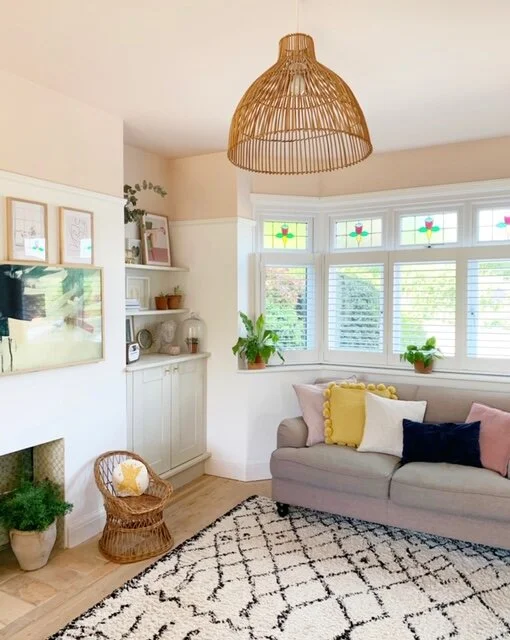DIY & Crafts
A sweet transformation of a second hand wooden chest of drawers using a coat of paint and some hand painted floral detail…
Are you fed-up with the paint bleeding through your decorator’s tape and just want to get a lovely crisp line? This blog is jam packed with helpful tips plus THE hack you need to know in order to use decorator’s tape successfully…
Create a striped wallpaper effect with this affordable paint trick using loose hand painted stripes…
Have you seen beautifully painted decorative furniture online and want to give it a go yourself? Follow these tips for everything you need to know to get started…
Love the look of bare plaster and wondering about keeping it as it rather than painting over it? Read our experience of living with bare plaster and why we decided it didn’t work for us…
Think outside the box with these fabulous wall mouldings and decor ideas that will give your walls personality and add that fun factor in to your home…
Choosing carpet for a family home is a big decision so I’ve unpacked the differences between polypropylene, wool and polyester to help you make a more informed choice…
Have a house to renovate but don’t know where to start? Having the wrong tool for the job can be so frustrating, so here’s my list of essential tools you need in your toolkit to help you get started…
We’ve lived in our thatched cottage for four years and there are some important pro’s and con’s to consider when living life under a thatched roof. Read on to find out what they are…
See how this dark and gloomy staircase was transformed by the building of a bespoke bookshelf painted in a warm yellow…
Painting kitchen cupboards is a big task but can be completely transformative if done well. Read on for my tips to ensure you achieve a beautiful paint finish that is not only durable but looks professional too.
How to transform your wooden floor boards with a checkerboard paint pattern. This guide includes everything you need to know for a professional looking and durable finish.
The transformation of a small awkward space in to a toy room with bespoke storage and the use of colour drenching to help the room feel cosy and cohesive.
Wondering which sander to buy as a DIY beginner? Read my review of the three electric sanders I have…
Painting an old radiator is a great and easy way to help it blend into your décor, creating a seamless and coordinated look on a budget.
As we have never been blessed with particularly pretty radiators - think dated and grubby with the previous owners’ old knickers found behind them kind of radiators - I love to colour match them to the walls so they ‘disappear’ and let other design features in the room stand out.
As we’re well into our third lockdown, this project could not be anymore timely as we all try desperately to find a corner of peace within our own homes. Our kids absolutely love playing in here, and whilst it is currently the only corner of the whole home that actually looks decent, you’ll probably find me hiding in here too - most likely with a sneaky bar of chocolate before they find me!
Thankfully this room already has a lot of built in storage so whilst the girls are still young, and they’re not fighting over wardrobe space, it made sense to turn this area into something more fun. The doors were warped and didn’t close properly so they would have needed replacing anyway. This felt like a much cheaper and immediate solution.
Kitchens are an expensive room to renovate and more often than not, we need to find solutions that make what we already have work for us. One inexpensive way to do this is to install a curtain to hide any ugly appliances or clutter you may have on show. Our utility room sits right next to our kitchen and is used as a part utility/part kitchen with our fridge/freezer, microwave, dishwasher and washing machine in there alongside a utility cupboard, coat storage and boiler. The previous owners didn’t have a dishwasher, so we had to make space for both our appliances by cutting out the cupboard that previously sat where the curtain now is. Thankfully the worktop was supported by brackets above, so it was a simple job completed with a circular saw and a lot of noise (it also made the fire alarm go off!) whilst the kids miraculously stayed asleep one evening.
This is an honest review, written and shared in return for some gifted shutters from California Shutters. Use the discount code OTTO25 for 25% off – code valid until 25/08/2020.
We have been living with no window treatments downstairs for over 18 months. So long, I’d almost forgotten that everyone could see right into our front room from the relatively busy path outside. I’ve never been someone who is overly private, and would always prefer good light during the day over a window covering, but even I began to feel like having people casually snooping on us from outside on the regular was a step too far!
Our Ikea Duktig kitchen is definitely our most played with toy. With two girls under five, it has been well loved for over four years and was beginning to show a few signs of looking tired. I've always wanted to upcycle it, and over the years have had various designs in mind, but renovating two houses and a house move took priority over less essential (but way more fun) projects like this one.If you've been following me for a while, you'll know we have given our real kitchen a temporary update, whilst we save for an extension. This project, therefore, gave me a chance to put my plywood and ribbed wood dreams into real life, albeit on a smaller scale!! It has also meant I had a chance to change two of the only things I found impractical about the play kitchen - the fact that all the toys fell down the back, and the plastic hooks which the kids constantly pulled off and scattered around the house.
Naff. That was the first thought in my mind when I came across tile stickers.But then we moved to this house with a lime green kitchen and my opinion began to change. I knew we needed to come up with a quick and cheap solution so we could transform it (or at the very least, make it 'liveable') before all the major building works began.You can find tile stickers on eBay and Amazon, but after heaps of searching, we personally struck gold with moonwallstickers.com. It's an unassuming website, with limited and rather uninspiring social media activity but, my oh my, some of the tile stickers on there are gorgeous! (This is NOT an ad by the way!) There are also multiple size options available for every design making it compatible with the tiles you already have.
Limepaint or limewash is a natural eco-friendly paint which, when applied with a brush, creates a beautiful textured finish and thanks to modern companies like Bauwerk Colour and Kalkliter, comes in a wide range of stunning colours. So why did it all go so wrong?I have loved the look for awhile, whether it be in Moroccan décor or in more contemporary settings and I felt this paint might just be the 'piece de resistance' needed in our bedroom. I like the calming nature of an all-white bedroom but felt by injecting some texture it would help give it depth and interest.
I can honestly say it's the best £1000 we've ever spent. We've never had a huge budget for doing up this house, but to spend 1/6 of that on getting rid of the old UPVC door and transforming our homes curb appeal was definitely the best decision we ever made. I absolutely hated our old door, and I hate to admit I'm this shallow, but it genuinely made me feel embarrassed about the house. We'd worked so hard on transforming the interiors, but 95% of people only ever saw that horrible plastic white thing more akin to a static caravan home than a Victorian cottage in the beautiful South Downs National Park. I remember our first Christmas in the village, taking Darcey for a little walk in the pram to get some fresh air and coming home to Matt exclaiming 'I swear we have the only UPVC door in the WHOLE village, everyone has beautiful Christmas wreaths on their beautiful Farrow and Ball doors and ours is just BLEURGH!!!' (You may come to realise I'm never one to understate my feelings...)
Before we bought 'The Otto House' we rented a large, detached three-bedroom house with an enormous studio in the garden. Like many here in the South of England we had to downsize to get on the property ladder so storage has always been a bit of an ongoing challenge. I am a curtain-maker by trade and not only used the old garden studio for making curtains but also for hoarding HEAPS of fabric, wallpaper, paint, magazines, books and anything else remotely crafty. It was like a creative paradise to me and something which I am sure I will never have again, but I am so very grateful for the two glorious years I spent stitching away in there whilst the sun streamed through the double doors. (And the winters spent in a coat, hat and gloves bent shivering over my sewing machine, but, you know, that sounded less poetic!)
As first time home owners there are certainly many things you have to consider that I'd never even thought of before. Now don't get me wrong, I am really happy with the overall finish and we certainly have made a huge aesthetic transformation to what we started with, but there are some aspects of our renovation that I would do differently if I could.So, firstly, why the rush?!We were living in rented accommodation and managed to get a three week overlap where we could live in the comfort of one home, whilst drastically changing the next. Most of the work required was dusty and messy and in a small two-bed, we knew there would be no 'give' once we'd moved us, a baby, and all our stuff in, so we really needed it to be liveable and child-safe by the end of those three weeks.
People often ask us how on earth we do it all whilst looking after the children and to be honest with you, there is no magic answer. There is no wand that turns a dingy and dated hallway into a new fresh, practical and modern entrance unless you're willing to put in the hard work (or hard-earned cash). Whilst we don't have much of the latter, we have attempted (and completed) many DIY jobs around the house so here's a few tips that we've learnt along the way...
Two of the things that get the most comments over on my Instagram @theottohouse are our bathroom tiles and this exposed brick wall. It really was so very simple to do and at next-to-nothing cost, is a great way to add character to a room on a low budget, but despite that we still felt pretty intimidated by the job and almost didn't go for it. Do you have similar apprehensions? Read on to see how we did it and how we feel about living with exposed brick, one year on.





























A tools list and step by step tutorial on how to prep and paint upvc windows for a brilliant finish…